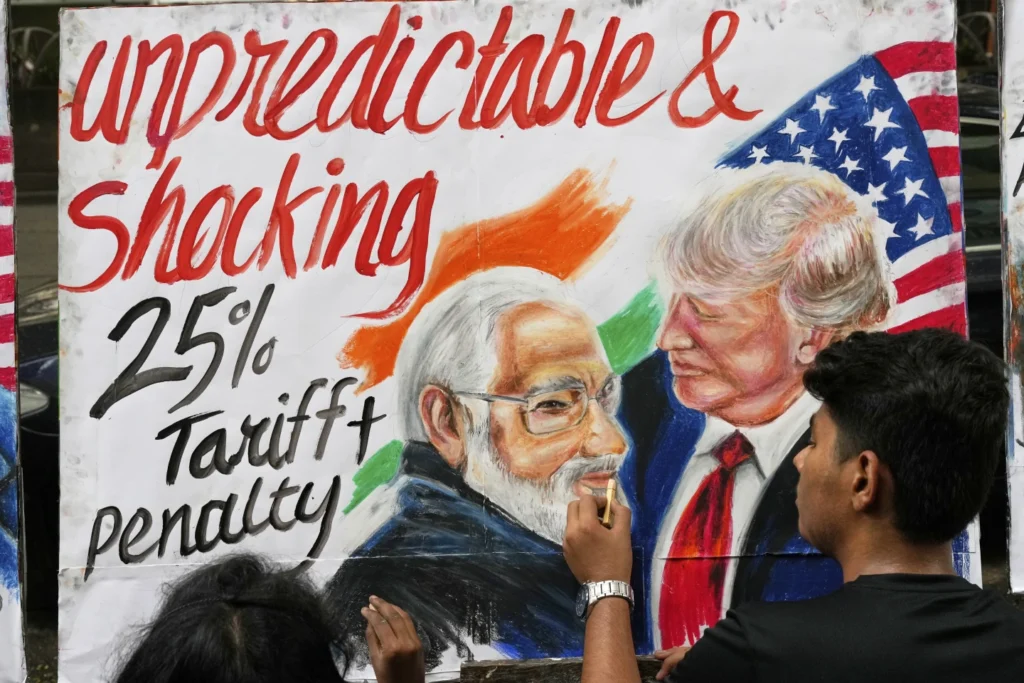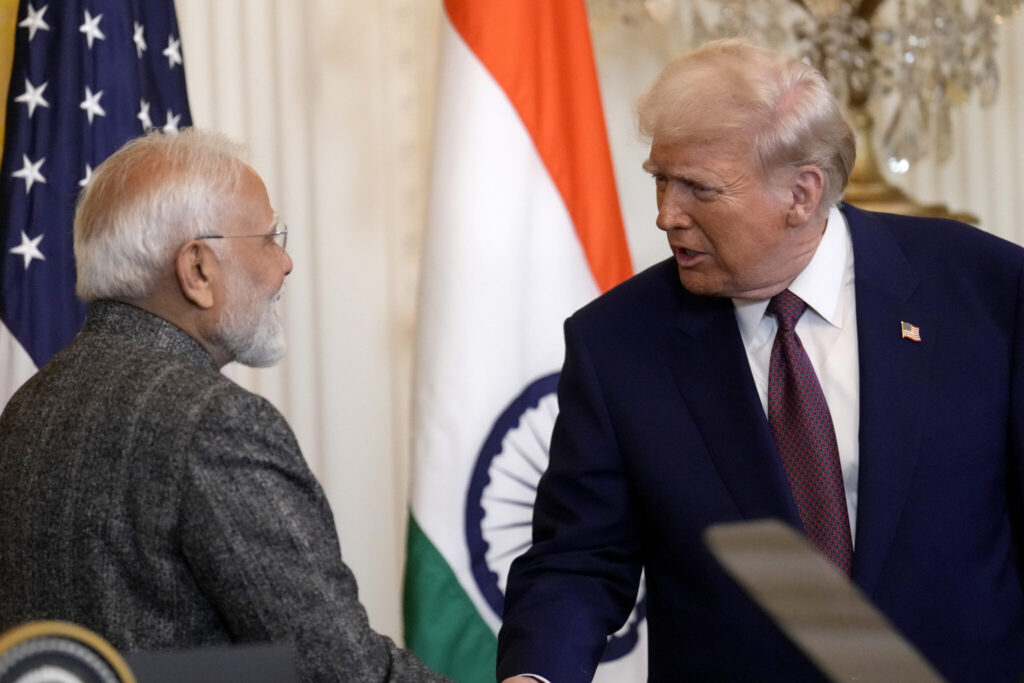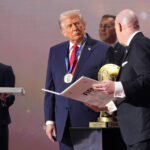Trump’s 50% Tariffs on India Over Russian Oil Now in Effect/ Newslooks/ WASHINGTON/ J. Mansour/ Morning Edition/ President Donald Trump’s 50% tariffs on Indian goods have taken effect, impacting nearly $48.2 billion in exports. India warns of job losses and economic slowdown, especially in textiles, jewelry, leather, and auto sectors. Prime Minister Modi vowed to resist U.S. pressure while pursuing local reforms and new trade deals abroad.

Trump’s India Tariffs Quick Looks
- Tariffs raised from 25% to 50% after India’s Russian oil imports.
- Nearly $48.2 billion worth of Indian exports to the U.S. affected.
- Labor-intensive industries like textiles, leather, and gems hardest hit.
- Pharmaceuticals and electronics exempted, easing some pressure.
- Exporters warn of immediate job losses and small-business strain.
- Modi vows to protect Indian farmers, dairy, and small businesses.
- India eyes EU, Africa, and Latin America for trade diversification.
Trump’s 50% Tariffs on India Over Russian Oil Now in Effect
Deep Look
The Trump administration’s new 50% tariffs on Indian exports officially came into force Wednesday, escalating tensions between the two allies and putting billions of dollars in trade at risk.
President Donald Trump initially imposed a 25% tariff on Indian products earlier this year. But after India expanded its purchases of Russian oil, he doubled down with an executive order that raised the tariff rate to 50%. The move directly affects $48.2 billion worth of Indian goods sold in the U.S. market — India’s largest export destination.
A Blow to India’s Export Economy
The Indian government has warned that the new tariffs could make many shipments to the U.S. commercially unviable, threatening hundreds of thousands of jobs in export-heavy sectors. Officials fear the tariffs will slow the growth of India’s economy, which has been among the fastest-expanding globally.
According to a report by the Global Trade Research Initiative, industries most exposed to the tariffs include textiles, gems and jewelry, leather goods, food products, and automobiles — sectors that employ millions of workers.
“This is a strategic shock that threatens to wipe out India’s long-established presence in the U.S., causing unemployment in export-driven hubs and weakening its role in the industrial value chain,” said Ajay Srivastava, founder of the think tank and a former trade official.
Pharmaceuticals and electronics were exempted from the new duties, offering some relief. These industries account for a large portion of India’s exports, and their exclusion prevents an even deeper economic impact.
Exporters Sound Alarm
For exporters on the ground, the consequences are already dire. Puran Dawar, a leather footwear manufacturer from Agra who supplies brands such as Zara, said the tariffs would devastate his industry unless demand strengthens in India or other foreign markets.
“This is an absolute shock,” Dawar said, noting that many Indian small and medium-sized businesses depend heavily on U.S. buyers. As regional chairman of the Council for Leather Exports, he warned that the steep duties would also hurt U.S. consumers by raising prices.
Ajay Sahai, director general of the Federation of Indian Export Organizations, echoed the concern.
“It’s a tricky situation. Some product lines will simply become unviable overnight,” he said.
Modi Pushes Back
The tariffs come amid ongoing trade negotiations between Washington and New Delhi. Despite five rounds of talks, the two countries remain divided — particularly over U.S. demands for greater access to India’s agriculture and dairy sectors.
Prime Minister Narendra Modi, speaking at a rally in Gujarat, vowed not to yield to U.S. pressure.
“For me, the interests of farmers, small businesses, and dairy are topmost. My government will ensure they aren’t impacted,” Modi declared, accusing wealthier nations of pursuing a “politics of economic selfishness.”
As a sign of strain, a U.S. delegation canceled its planned trip to New Delhi for a sixth round of trade talks this week.
India’s Economic Response
In response, India has begun formulating measures to cushion its economy from the fallout. The government is considering reducing the Goods and Services Tax (GST) on key consumer products such as cars, appliances, and insurance ahead of the Diwali festival season, in an effort to boost domestic consumption.
The Trade and Finance Ministries are also discussing new incentives for exporters, including subsidized loan programs to help companies weather the downturn.
Longer-term, India is looking to diversify its export markets. Trade negotiations with the European Union could accelerate, while officials are also eyeing new opportunities in Latin America, Africa, and Southeast Asia to reduce dependence on the U.S. market.
A Test for U.S.–India Relations
The tariff escalation marks one of the most serious economic disputes between Washington and New Delhi in recent years. Although the U.S. and India have expanded trade ties and deepened strategic cooperation, particularly in defense and technology, the new duties highlight persistent vulnerabilities in the relationship.
For India, the challenge will be maintaining economic momentum while managing the fallout from Washington’s protectionist shift. For Trump, the tariffs signal his continued willingness to use economic leverage as a foreign policy tool — even against U.S. allies.







